Business Ethics: Examining the Ethical Landscape of Tobacco Companies
VerifiedAdded on 2022/09/10
|5
|847
|23
Essay
AI Summary
This essay delves into the business ethics of tobacco companies, examining the ethical dilemmas associated with their products' production and distribution. It describes how the perception of tobacco products varies across cultures in the United States and globally, highlighting differing viewpoints and societal impacts. The essay analyzes how tobacco companies have addressed ethical implications through social responsibility, integrity, and business ethics, including their handling of product warnings and advertising regulations. Furthermore, it explores the role of leadership in fostering a culture of ethics within the marketing department, especially when advertising products with known health risks. The analysis incorporates peer-reviewed sources and APA guidelines to provide a comprehensive understanding of the subject.
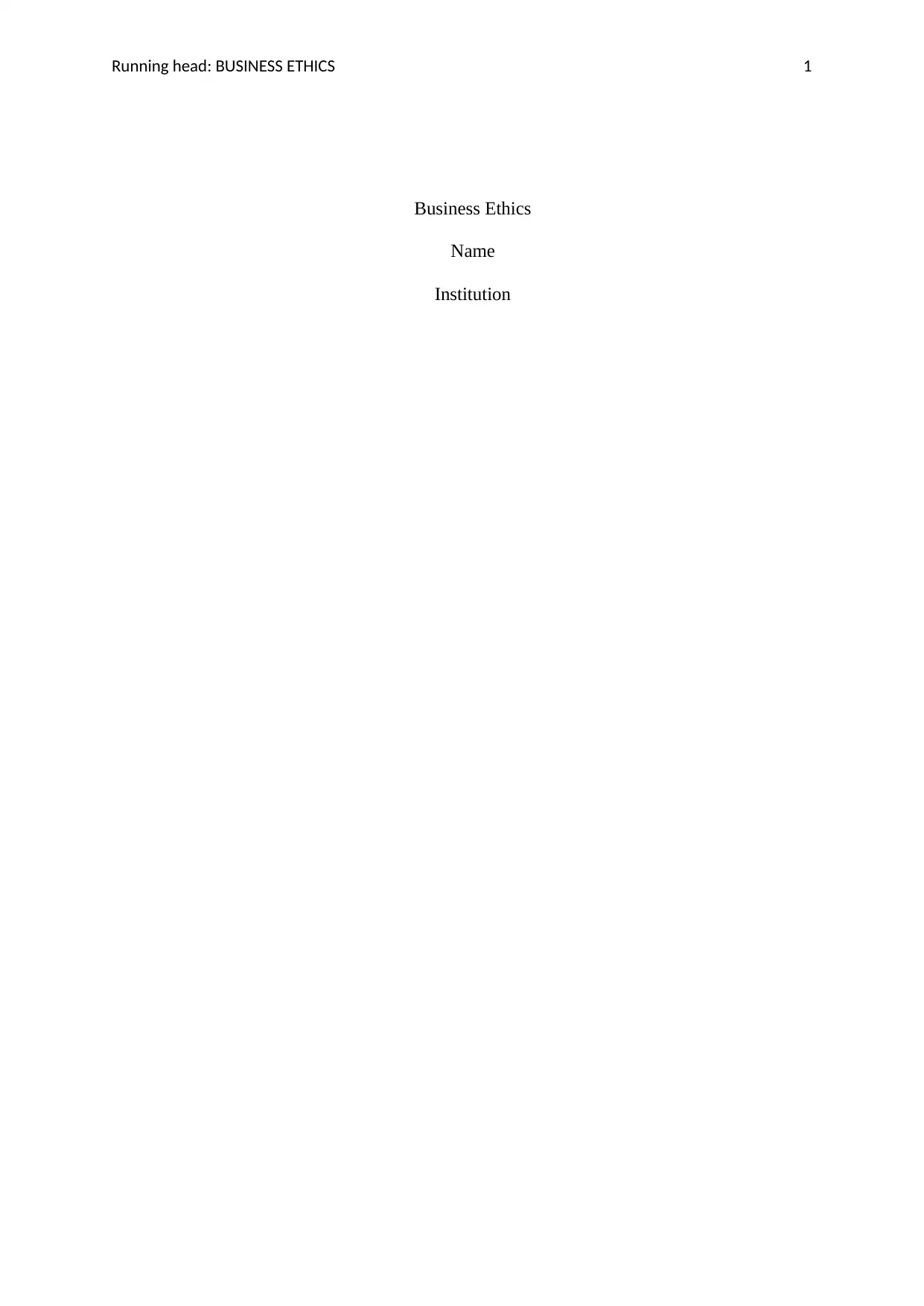
Running head: BUSINESS ETHICS 1
Business Ethics
Name
Institution
Business Ethics
Name
Institution
Paraphrase This Document
Need a fresh take? Get an instant paraphrase of this document with our AI Paraphraser
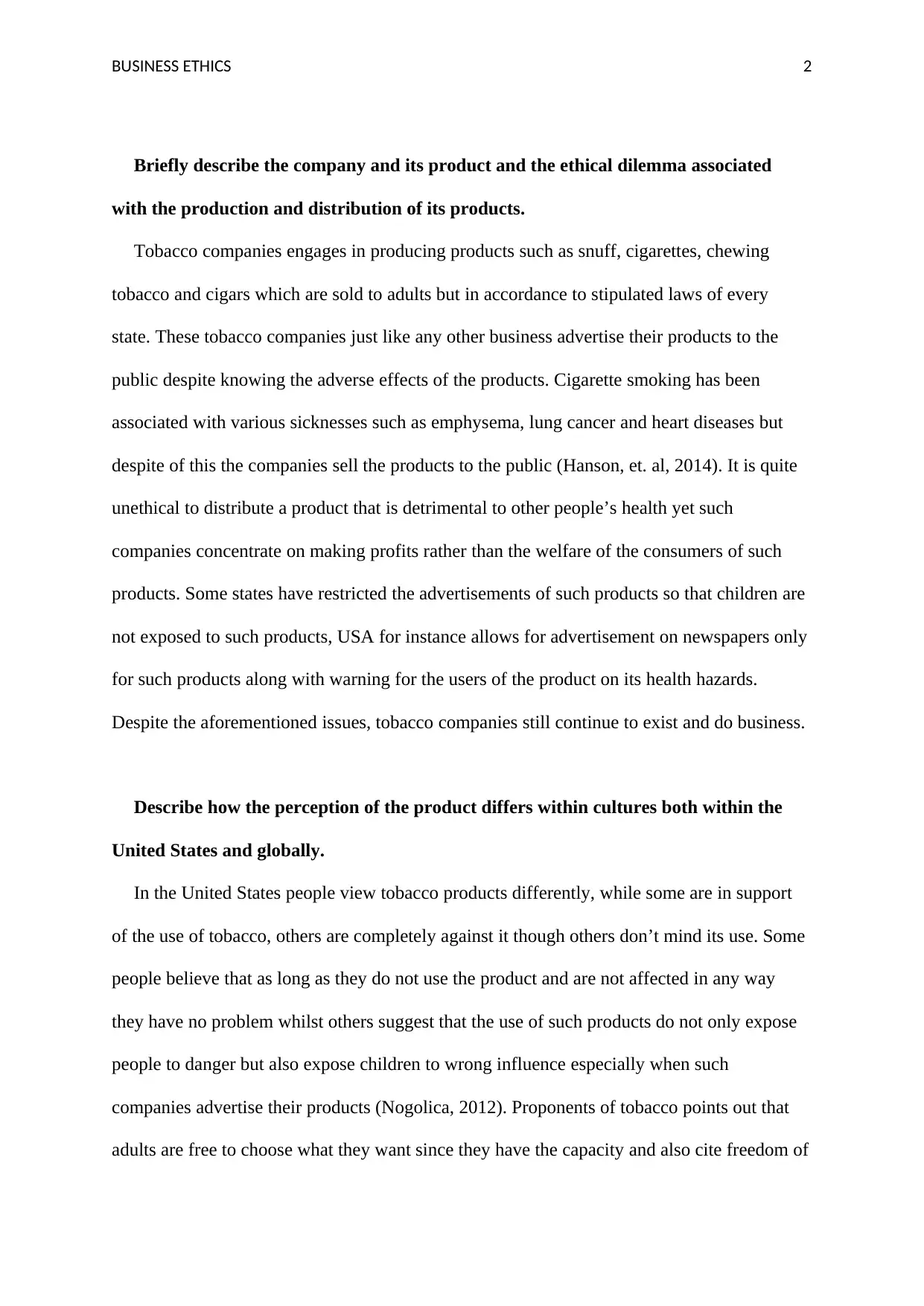
BUSINESS ETHICS 2
Briefly describe the company and its product and the ethical dilemma associated
with the production and distribution of its products.
Tobacco companies engages in producing products such as snuff, cigarettes, chewing
tobacco and cigars which are sold to adults but in accordance to stipulated laws of every
state. These tobacco companies just like any other business advertise their products to the
public despite knowing the adverse effects of the products. Cigarette smoking has been
associated with various sicknesses such as emphysema, lung cancer and heart diseases but
despite of this the companies sell the products to the public (Hanson, et. al, 2014). It is quite
unethical to distribute a product that is detrimental to other people’s health yet such
companies concentrate on making profits rather than the welfare of the consumers of such
products. Some states have restricted the advertisements of such products so that children are
not exposed to such products, USA for instance allows for advertisement on newspapers only
for such products along with warning for the users of the product on its health hazards.
Despite the aforementioned issues, tobacco companies still continue to exist and do business.
Describe how the perception of the product differs within cultures both within the
United States and globally.
In the United States people view tobacco products differently, while some are in support
of the use of tobacco, others are completely against it though others don’t mind its use. Some
people believe that as long as they do not use the product and are not affected in any way
they have no problem whilst others suggest that the use of such products do not only expose
people to danger but also expose children to wrong influence especially when such
companies advertise their products (Nogolica, 2012). Proponents of tobacco points out that
adults are free to choose what they want since they have the capacity and also cite freedom of
Briefly describe the company and its product and the ethical dilemma associated
with the production and distribution of its products.
Tobacco companies engages in producing products such as snuff, cigarettes, chewing
tobacco and cigars which are sold to adults but in accordance to stipulated laws of every
state. These tobacco companies just like any other business advertise their products to the
public despite knowing the adverse effects of the products. Cigarette smoking has been
associated with various sicknesses such as emphysema, lung cancer and heart diseases but
despite of this the companies sell the products to the public (Hanson, et. al, 2014). It is quite
unethical to distribute a product that is detrimental to other people’s health yet such
companies concentrate on making profits rather than the welfare of the consumers of such
products. Some states have restricted the advertisements of such products so that children are
not exposed to such products, USA for instance allows for advertisement on newspapers only
for such products along with warning for the users of the product on its health hazards.
Despite the aforementioned issues, tobacco companies still continue to exist and do business.
Describe how the perception of the product differs within cultures both within the
United States and globally.
In the United States people view tobacco products differently, while some are in support
of the use of tobacco, others are completely against it though others don’t mind its use. Some
people believe that as long as they do not use the product and are not affected in any way
they have no problem whilst others suggest that the use of such products do not only expose
people to danger but also expose children to wrong influence especially when such
companies advertise their products (Nogolica, 2012). Proponents of tobacco points out that
adults are free to choose what they want since they have the capacity and also cite freedom of
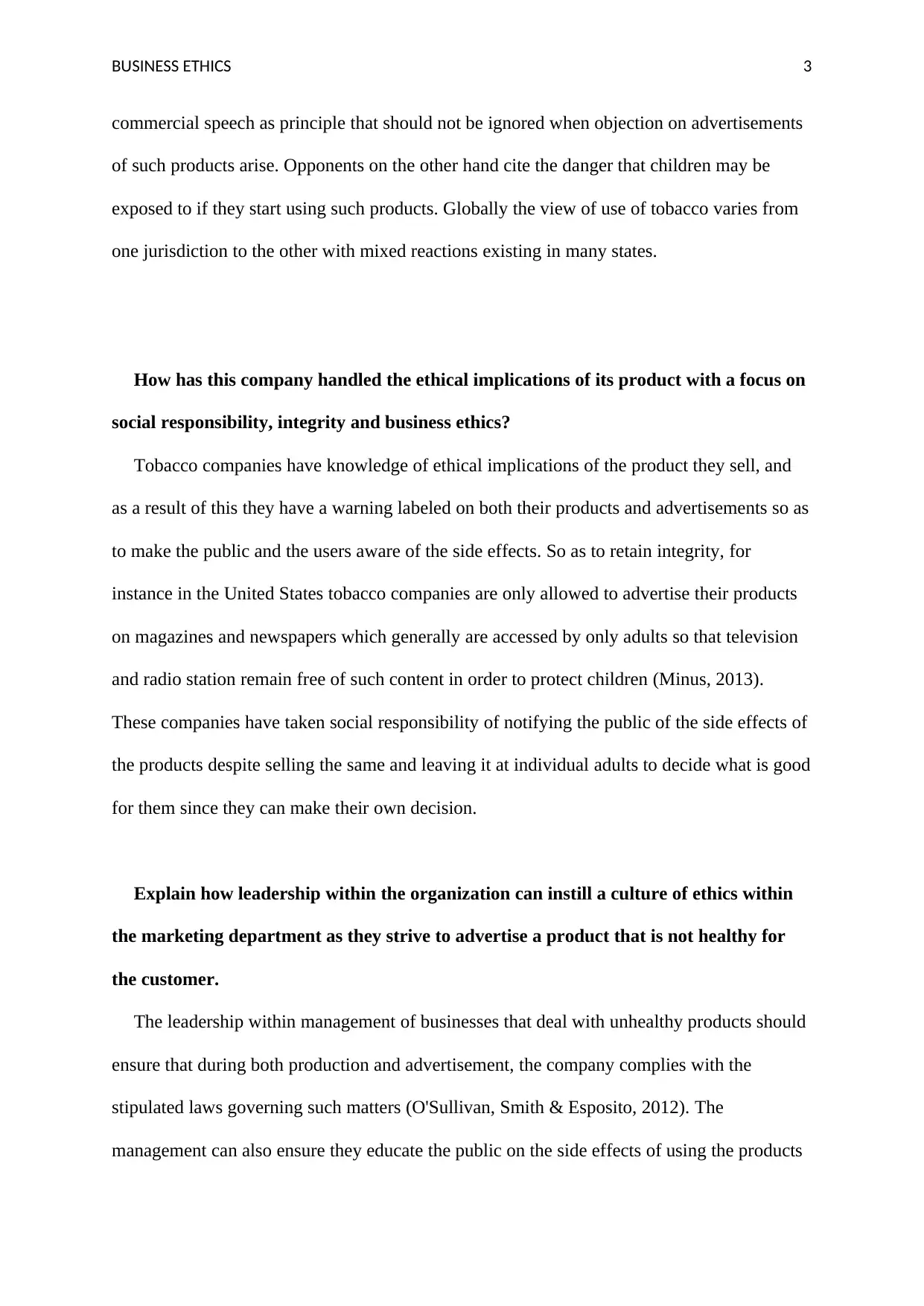
BUSINESS ETHICS 3
commercial speech as principle that should not be ignored when objection on advertisements
of such products arise. Opponents on the other hand cite the danger that children may be
exposed to if they start using such products. Globally the view of use of tobacco varies from
one jurisdiction to the other with mixed reactions existing in many states.
How has this company handled the ethical implications of its product with a focus on
social responsibility, integrity and business ethics?
Tobacco companies have knowledge of ethical implications of the product they sell, and
as a result of this they have a warning labeled on both their products and advertisements so as
to make the public and the users aware of the side effects. So as to retain integrity, for
instance in the United States tobacco companies are only allowed to advertise their products
on magazines and newspapers which generally are accessed by only adults so that television
and radio station remain free of such content in order to protect children (Minus, 2013).
These companies have taken social responsibility of notifying the public of the side effects of
the products despite selling the same and leaving it at individual adults to decide what is good
for them since they can make their own decision.
Explain how leadership within the organization can instill a culture of ethics within
the marketing department as they strive to advertise a product that is not healthy for
the customer.
The leadership within management of businesses that deal with unhealthy products should
ensure that during both production and advertisement, the company complies with the
stipulated laws governing such matters (O'Sullivan, Smith & Esposito, 2012). The
management can also ensure they educate the public on the side effects of using the products
commercial speech as principle that should not be ignored when objection on advertisements
of such products arise. Opponents on the other hand cite the danger that children may be
exposed to if they start using such products. Globally the view of use of tobacco varies from
one jurisdiction to the other with mixed reactions existing in many states.
How has this company handled the ethical implications of its product with a focus on
social responsibility, integrity and business ethics?
Tobacco companies have knowledge of ethical implications of the product they sell, and
as a result of this they have a warning labeled on both their products and advertisements so as
to make the public and the users aware of the side effects. So as to retain integrity, for
instance in the United States tobacco companies are only allowed to advertise their products
on magazines and newspapers which generally are accessed by only adults so that television
and radio station remain free of such content in order to protect children (Minus, 2013).
These companies have taken social responsibility of notifying the public of the side effects of
the products despite selling the same and leaving it at individual adults to decide what is good
for them since they can make their own decision.
Explain how leadership within the organization can instill a culture of ethics within
the marketing department as they strive to advertise a product that is not healthy for
the customer.
The leadership within management of businesses that deal with unhealthy products should
ensure that during both production and advertisement, the company complies with the
stipulated laws governing such matters (O'Sullivan, Smith & Esposito, 2012). The
management can also ensure they educate the public on the side effects of using the products
⊘ This is a preview!⊘
Do you want full access?
Subscribe today to unlock all pages.

Trusted by 1+ million students worldwide
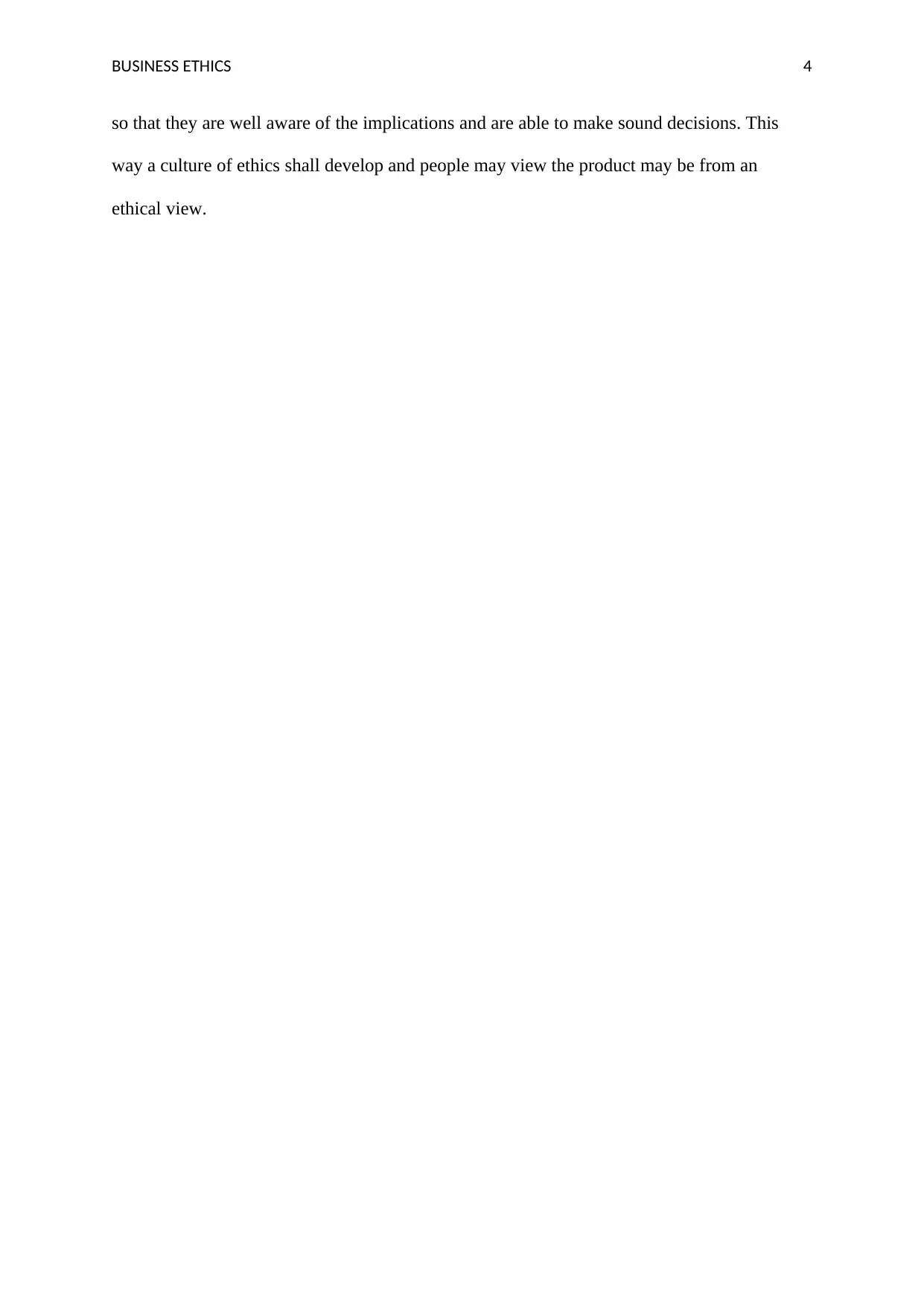
BUSINESS ETHICS 4
so that they are well aware of the implications and are able to make sound decisions. This
way a culture of ethics shall develop and people may view the product may be from an
ethical view.
so that they are well aware of the implications and are able to make sound decisions. This
way a culture of ethics shall develop and people may view the product may be from an
ethical view.
Paraphrase This Document
Need a fresh take? Get an instant paraphrase of this document with our AI Paraphraser
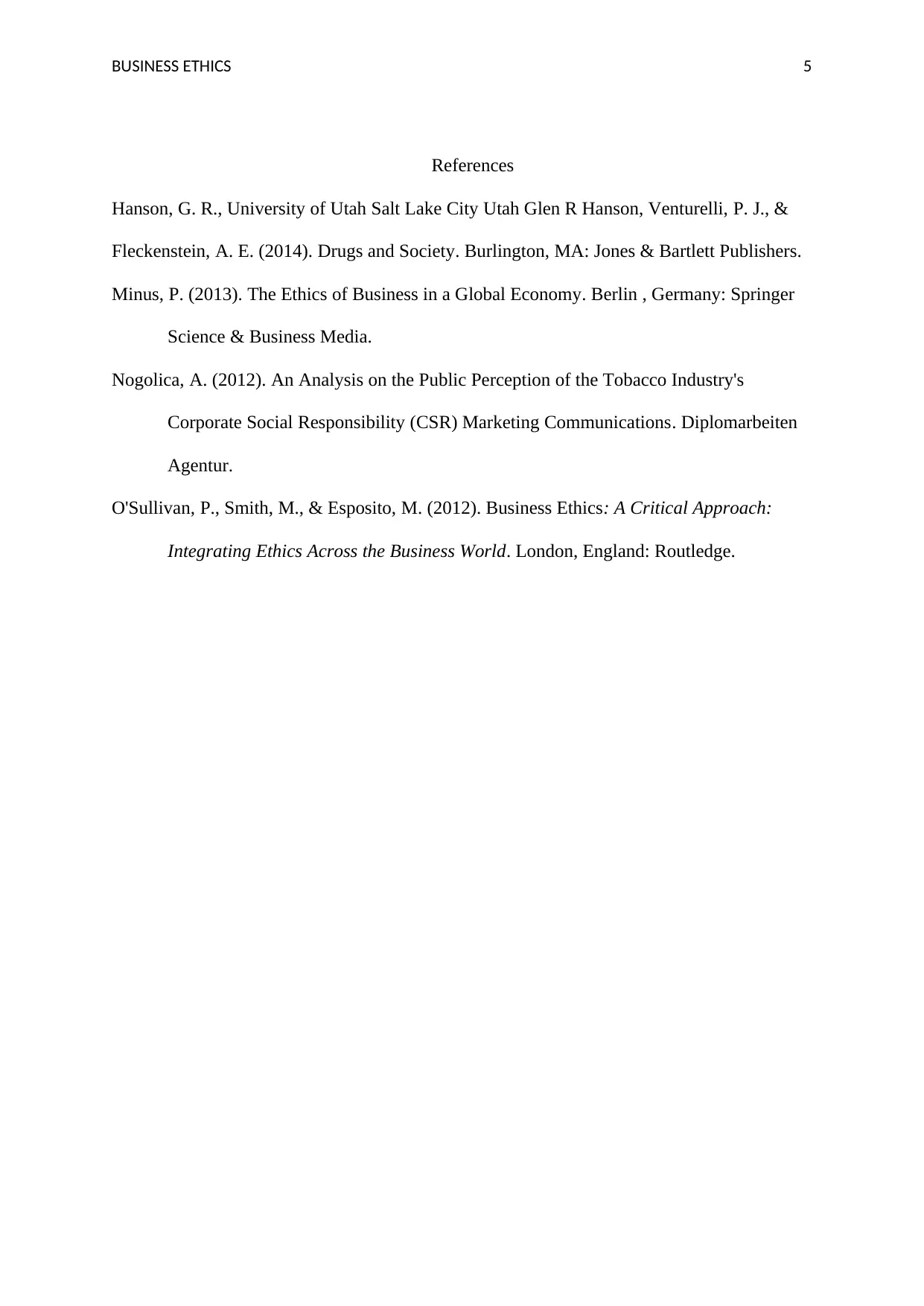
BUSINESS ETHICS 5
References
Hanson, G. R., University of Utah Salt Lake City Utah Glen R Hanson, Venturelli, P. J., &
Fleckenstein, A. E. (2014). Drugs and Society. Burlington, MA: Jones & Bartlett Publishers.
Minus, P. (2013). The Ethics of Business in a Global Economy. Berlin , Germany: Springer
Science & Business Media.
Nogolica, A. (2012). An Analysis on the Public Perception of the Tobacco Industry's
Corporate Social Responsibility (CSR) Marketing Communications. Diplomarbeiten
Agentur.
O'Sullivan, P., Smith, M., & Esposito, M. (2012). Business Ethics: A Critical Approach:
Integrating Ethics Across the Business World. London, England: Routledge.
References
Hanson, G. R., University of Utah Salt Lake City Utah Glen R Hanson, Venturelli, P. J., &
Fleckenstein, A. E. (2014). Drugs and Society. Burlington, MA: Jones & Bartlett Publishers.
Minus, P. (2013). The Ethics of Business in a Global Economy. Berlin , Germany: Springer
Science & Business Media.
Nogolica, A. (2012). An Analysis on the Public Perception of the Tobacco Industry's
Corporate Social Responsibility (CSR) Marketing Communications. Diplomarbeiten
Agentur.
O'Sullivan, P., Smith, M., & Esposito, M. (2012). Business Ethics: A Critical Approach:
Integrating Ethics Across the Business World. London, England: Routledge.
1 out of 5
Related Documents
Your All-in-One AI-Powered Toolkit for Academic Success.
+13062052269
info@desklib.com
Available 24*7 on WhatsApp / Email
![[object Object]](/_next/static/media/star-bottom.7253800d.svg)
Unlock your academic potential
Copyright © 2020–2025 A2Z Services. All Rights Reserved. Developed and managed by ZUCOL.





